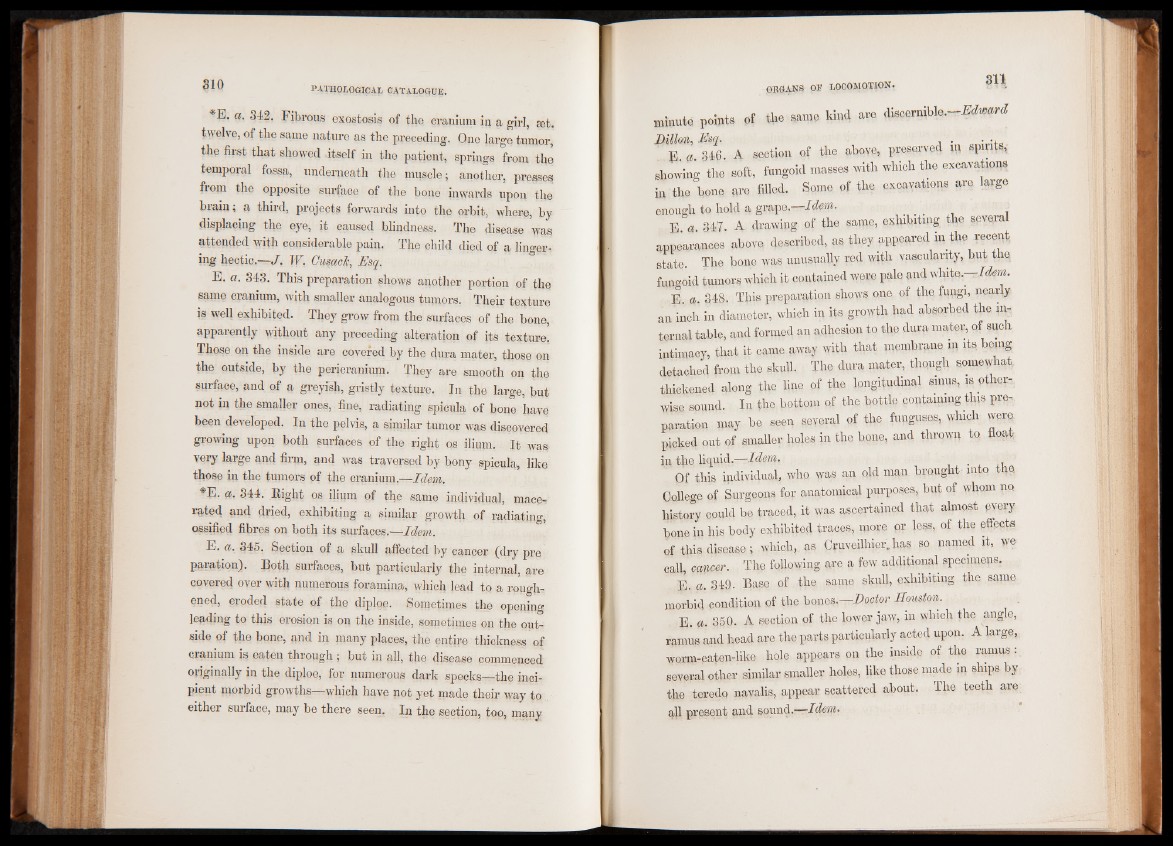
*E. a. 342, Fibrous exostosis of the cranium in a girl, ast.
twelve, of the same natpre as the preceding. Ope large tumor,
the first that showed itself in the patient, springs from the
temporal fossa, underneath the muscle; another, presses
from the opposite surface of the bone inwards upon the
bram; a third, projects forwards into the orbit, where, by
displacing the eye, it caused blindness. The disease was
attended with considerable pain. The child died of a linger,
ing hectic.—J. W. GusacJc, Esq.
E. a. 343. This preparation shows another portion of the
same cranium, with smaller analogous tumors. Their texture
is well exhibited. They grow from the surfaces of the bone,
apparently without any preceding alteration of its texture.
Those on the inside are covered by the dura mater, those on
the outside, by the pericranium. They are smooth on the
surface, and of a greyish, gristly texture. In the large, but
not in the smaller ones, fine, radiating spicula of bone have
been developed. In the pelvis, a similar tumor was discovered
growing upon both surfaces of the right qs ilium. It was
yery large and firm, and was traversed by bony spicula, like
those in the tumors of the cranium.—Idem.
*E. a. 344. Right os ilium of the same individual, macerated
and dried, exhibiting a. similar growth, of radiating,
ossified fibres on both its surfaces.—Idem.
E. a. o45. Section of a skull affected by cancer (dry prp
payation). Both surfaces, but particularly the internal, are
covered over with numerous foramina, which lead to a roughened,
eroded state of the diplop. Sometimes the opening
leading to this erosion is on the inside, sometimes on the outside
of (he bone, and in many places, the entire thickness of
cranium is eaten through ; but in all, the disease commenced
originally in the diploe, for numerous dark specks—the incipient
morbid growths—which have not yet made their way to
either surface, may be there seen. Ip the section, too, many
rcinutt points of * . m » m fj* d iscern ib le.-^ » ^
; E. a. 34fi. A section of the above, preserved W i *
showing the soft, fungoid masses with which the excavations
in the bone are filled. Some, of the excavations are large
enough E a. t3o4 h7-o ldA a dgrraawpien.g oIdf etmh-e same, exhibit|ing the several
appearances above, described, as they appeanid in the reccpt
state. The bone was unusually red with vascularity, hut tM
fungoid tumors which it contained were pale and white —Idem.
E. a. 348. This preparation shows one of the. fungi, neatly
an inch in diameter, which in its growth had absorbed the internal
table, and formed an adhesion to the dura mater, of such
intimacy, that it came away with that membrane m its. being
detached from the skull. The dura mater, though somewhat,
thickened along the line of fhe longitudinal sinus, is other,
wise sound. In the bottom of the bottle containing this preparation
may be. seen ^eyeral of the funguses, which were,
in Othfe tlhiiqsu iidn.d—ivIiddeumal-, who was an old man brought into t,he
College of Surgeons for anatomical purposes, but of whom no
history could be traced, it was ascertained that almost every
bone in his body exhibited traces, more pr less, of the #pcts
Qf this disease; which, as Cyuveilhier. has so napied it, we
„„U ‘ cancer The following are a few additional specimens.
E. ! 349. Base of the same skull, exhibiting the same
morbid condition of the bqnes,—Doctor Houston. I
E. a. 350. A section of the lower jaw, in which the angle,
ramus and head are the parts particularly acted upon. A large,
worm-eaten-like hole appears on the insidp of the ramps:
several other similar smaller holes, like those made in ships by
the teredo navalis, appear scattered about. The teeth are
all present and sound.—Idem.